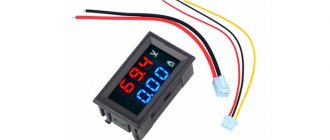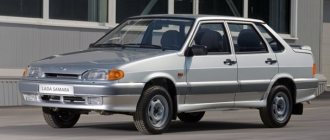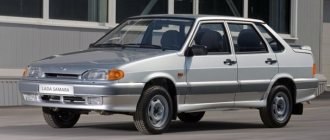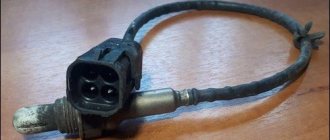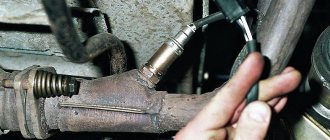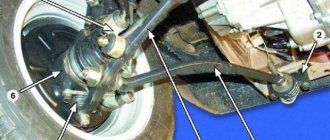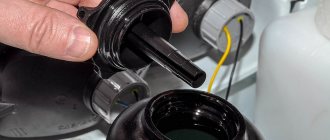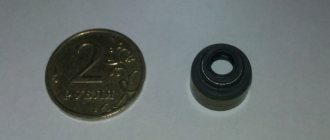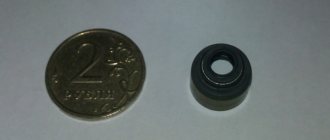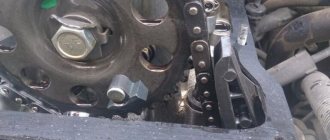#1 Mikhail
- Moderators
- 3,256 messages
A friend of mine has been using the Lada Granta for more than six months.
Occasionally the check engine light would come on, but I told her not to bother, especially in the off-season. Moreover, the swearing itself goes out after a while.
The other day, after refueling (Lukoil, AI-95), not only did the icon light up, but the car began to noticeably kick and shake. Taking into account the automatic transmission, it’s completely unpleasant.
I went to the service.
The diagnosis was made: bad fuel, injectors need to be replaced. Moreover, the case is not guaranteed, pay half your salary to the cashier and then sue Lukoil, fortunately you have the check in your hands.
My friend was smart enough to refuse.
Then two options were proposed: ultrasonic cleaning or special washing. The second is cheaper and faster - so she chose flushing. We also changed the spark plugs.
Result: the check went out, the car drove well, my wallet was lighter by 3,000 rubles.
Now the question that has been tormenting me for three days: isn’t this a scam?
A full tank of fuel (allegedly the culprit) - no one drained it or even offered it.
I looked at the removed spark plugs - they are normal, well, maybe you can use a brush a little.
I myself was a bit of a mess back in the last century, so my knowledge is of little use.
Do you think the servicemen mocked the blonde, or does washing the injectors (without draining the fuel) on Grant make sense?
Source forum.zr.ru
Checking and replacing injectors on a Lada Granta car
Tools (for 8 valve engines):
Tools (for 16 valve engines):
- Tester
- Medium Phillips screwdriver
- Medium flat screwdriver
- Open-end wrench 10 mm
- Open-end wrench 17 mm - 2 pcs.
- Ratchet wrench
- Extension
- 13 mm head
- 5 mm hex key
Parts and consumables:
- Injectors
- Injector O-rings
- Carburetor Cleaner
- Engine oil
- Rags
If the injectors on a car fail, the following signs of injector malfunction are possible: - difficult starting of the engine; — unstable engine operation; — the engine stalls at idle; — increased crankshaft rotation speed at idle; — the engine does not develop full power, insufficient engine response; — jerks and dips in engine operation when the car is moving; — increased fuel consumption; — increased content of CO and CH in the exhaust gases; — glow ignition due to leaking injectors.
In points where there are two photos, the first shows the process on an 8-valve engine, and the second on a 16-valve engine.
1. Disconnect the injector wire and engine harness connectors as described here (for 8-valve engines) or here (for 16-valve engines.
2. Perform an initial check of the injector windings. To do this, connect the tester to the connector contacts one by one.
The connector has five contacts: four for supplying a control signal to the injectors and one for common ground (a crimson wire with a black stripe is connected to it).
3. In turn, connect each of the four control contacts to the common contact and measure the resistance in each case.
It should be equal to 11-15 Ohms. If one or more measurements show resistance different from the specified value, some injectors are faulty.
4. To more accurately check the injectors, remove the fuel rail from the vehicle as described here (for 8-valve engines) or here (for 16-valve engines.
5. Remove the injectors from the fuel rail as described here (for 8-valve engines) or here (for 16-valve engines.
6. To identify a faulty injector, connect a tester to the injector contacts in ohmmeter mode.
It should show a resistance of 11-15 ohms. If the winding resistance is not normal, replace the injector, as it cannot be repaired.
In case of replacement, buy new injectors with exactly the same markings.
7. Check the injector for the shape of the fuel spray and for leaks at a specialized service station, since such a test directly on the car is very fire hazardous.
8. Whenever you remove injectors, be sure to replace the O-rings on all injectors on the fuel rail side and on the sprayer side.
9. If you are installing old injectors, carefully wash their nozzles with solvent or carburetor cleaner.
It is not allowed to wash the injectors by immersing them in a detergent composition to avoid damaging their electrical parts.
10. Install the injectors on the fuel rail in the reverse order of removal.
Before installing the injectors, lubricate the O-rings with engine oil.
11. Having installed the fuel rail on the intake pipe and connecting the pipeline to the fuel rail, start the engine and check the tightness of the connection of the pipeline and the injector seals.
The article is missing:
How to determine that injectors need to be cleaned
In general, experts advise carrying out this operation every 30,000 kilometers. Especially taking into account the quality of fuel at domestic gas stations. Here are the main signs that the injectors are clogged:
- engine starting is difficult;
- strong vibration of the car after starting the engine;
- unstable operation at idle speed;
- engine power is lost, throttle response deteriorates;
- increased fuel consumption;
- engine malfunctions during acceleration;
Such symptoms do not appear immediately, progress gradually and are clearly noticeable when the average mileage has already begun to reach about 100,000 kilometers. However, the worse the quality of the fuel and the general condition of the power system, the sooner this will happen.
Checking and replacing VAZ 2190 Granta injectors
Removal of fuel injectors on a VAZ 2190 Granta car is carried out to check them and subsequently replace faulty ones. To carry out repair work, you will need a five-point hex wrench, a screwdriver, a seventeen-point wrench and a tester to check the resistance of the windings. Checks for spray pattern shape and tightness should be carried out at technical inspection stations.
If you have everything you need, do the following:
We disconnect the connector with the power wires of the injectors and carry out their initial check. The block with wires has four connectors supplying impulses to the injectors and one common ground wire. We alternately connect one terminal of the tester to ground and the second to the terminals and check the resistance of the windings, which should be in the range of 0.011-0.015 kOhm. If there are deviations from the recommended values, then one of the injectors is faulty.
Now that the initial check has been completed, you can begin to remove them and determine the faulty one and replace it. To do this you need:
- We press the lock and disconnect the connector with wires from the injector.
- Next, use a flat screwdriver to pry up the spring retainer of its fastening and remove it.
- We remove the injector from the fuel rail and do the same with the others. We connect a tester to its terminals and again measure the winding resistance, which should also be in the range of 0.011-0.015 kOhm. If the resistance is not normal, change it.
- Each time you remove the injectors, replace the O-rings on the rail side and the intake manifold side.
- Reassemble and install in the reverse order. Upon completion of work, start the engine and check the tightness of the pipeline connections and injector seals.
At this point, the repair work to check and replace injectors on the VAZ 2190 Granta car with VAZ 11183, 21116 and 11186 engines has been completed.
Description of the check valve installation process
A delay in the supply of fluid to the windshield at the initial moment of movement of the wipers leads to the passage of these devices over a dry surface, which contributes to the appearance of scratches and abrasions. Not only Grant owners, but also owners of cars of other models are familiar with such a defect. A simple modification of the washer system will help eliminate it.
To ensure that liquid gets onto the windows at the very beginning of the wipers' movement, the washer systems of expensive cars are equipped with a check valve, which must be installed on the Grant. For this purpose, for example, an element from a Toyota car (article 85321-26020) is suitable, the estimated cost of which can vary from 50 to 150 rubles.
The DIY installation procedure is quite simple. First, cut the washer hose, then install the valve in the cut so that the arrow on it is located in the direction in which the liquid will move. Installation completed.
Removing the fuel rail and injectors of VAZ 11183, VAZ 21116 and VAZ 11186 Lada Granta engines
- Medium Phillips screwdriver
- Medium flat screwdriver
- 5 mm hex key
- Open-end wrench 17 mm - 2 pcs.
Parts and consumables:
- Injector O-rings
- Fuel injectors (if required)
- Engine oil
Remove the fuel rail to check the injectors and replace them, as well as when removing the intake pipe.
1. Relieve pressure in the engine supply system as described here.
2. Remove the air supply hose with the throttle assembly as described here and here.
3. Using a flat-head screwdriver, press the retainer of the engine management system wiring harness block and disconnect it from the injector wiring harness block.
4. Using a 17 mm wrench, unscrew the fitting of the fuel rail tube, holding the tip of the fuel supply hose to the rail with a wrench of the same size, and remove the tip of the fuel supply hose from the ramp tube.
The connection is sealed with a rubber ring.
5. Using a 5 mm hex key, unscrew one screw each securing the ramp to the inlet pipe on the left and right sides.
6. By pulling the ramp along the axes of the injectors and overcoming the resistance of the rubber sealing rings of the injectors, remove all four injectors from the holes in the intake pipe. Place the fuel rail assembly with injectors to the left side of the car and remove it from the engine compartment.
7. Squeezing the spring clamp of the wiring harness block, disconnect the block from the injector connector.
8. Similarly, disconnect the wiring harness connectors from the connectors of the other injectors.
9. Use a screwdriver to pry the bracket that secures the injector onto the ramp and remove the bracket.
10. Overcoming the resistance of the rubber sealing ring, remove the nozzle from the ramp pipe.
11. Remove the other injectors in the same way.
12. Using the blade of a flat-head screwdriver, remove the rubber o-rings of the injector.
13. Replace the injector sealing rings with new ones.
14. Before installing the injectors, apply a thin layer of engine oil to the O-rings.
15. Assemble and install the fuel rail in the reverse order.
The article is missing:
- Photo of the instrument
- Photos of parts and consumables

